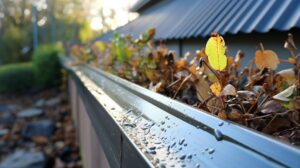The traditional challenges an experienced gutter cleaner faces are blocked downpipes, accumulated debris, safety risks, and weather conditions.
Blocked downpipes often result from leaves, twigs, and other detritus that accumulate over time. Accumulated debris blocks the flow of rainwater and can become a breeding ground for pests, like mosquitoes, and may cause rusting or corrosion over time.
For this blog, we’ll discuss the materials used to make gutters and the most popular gutter guard technologies today.
What Materials Are Used in Making Gutter Systems?
The materials commonly used in making gutter systems are aluminium, vinyl (PVC), copper, steel, zinc, wood, and fibreglass.
- Aluminium: This is one of the most popular materials for gutters due to its lightweight nature, resistance to rust, and ability to be easily shaped.
- Vinyl (PVC): A choice for those seeking an affordable and lightweight option, vinyl gutters are rust-resistant.
- Copper: Preferred for its elegant appearance, copper gutters develop a beautiful patina over time.
- Steel: Galvanised steel gutters are known for their strength but can rust if not maintained properly.
- Zinc: Often found in high-end projects, zinc gutters are durable and develop a patina over time, much like copper.
- Wood: Less common in modern times but can still be found in some historic or traditional homes.
- Fibreglass: This material is durable and resistant to rust, corrosion, and typical wear and tear.
What Are Seamless Gutters?
Seamless gutters are a type of rain gutter system specifically designed to have minimal seams or joints, setting them apart from traditional sectional gutters. They are custom-made for each property, ensuring a precise fit for every installation.
Unlike sectional gutters which are pieced together from smaller sections, seamless gutters are usually manufactured on-site using special machines that extrude materials like aluminium or copper to the exact length needed. The primary advantage of this design is the significant reduction in potential leak points, resulting in less hassle during gutter cleaning.

What Are Some of the Most Popular Gutter Guard Technologies Today?
Here are some of the most popular gutter guard technologies today:
- Mesh or Micro-Mesh Guards: Fine screens that fit over the top of gutters, allowing water to seep through while blocking leaves and debris.
- Reverse Curve or Surface Tension Guards: Designed with a curved nose to direct water into the gutter while pushing debris off to the ground below.
- Bottle Brush Guards: These use cylindrical bristles, resembling a bottle brush, standing upright inside the gutter to prevent debris from settling while letting water flow through.
- Foam Guards: Foam inserts placed inside the gutter allow water to seep through but block larger debris from entering.
- Slit Guards: These have small slits or openings designed to let water in while keeping out larger debris, using the principle of water tension.
Are There Eco-friendly Gutter Innovations?
Yes, there are eco-friendly gutter innovations. Some gutters are made from recycled materials, reducing the demand for new raw resources and decreasing environmental impact.

Rainwater harvesting systems, often integrated with gutters, enable homeowners to collect and store rainwater for garden irrigation or other uses, conserving water resources.
Additionally, gutter guards reduce the need for frequent cleanings, decreasing the water and potential chemical use associated with maintenance.
